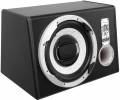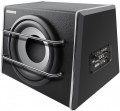Size
The size (diameter) of the main subwoofer speaker. In all types of subwoofers, this parameter primarily affects the power and depth of sound: the larger the speaker, the louder it is and the deeper the bass it can provide (ceteris paribus). However with an increase in the size and dimensions, they increase accordingly, which determines the installation possibilities. The latter is especially true in Free Air subwoofers (see "Execution"): some cars are initially equipped with "seats" for a certain size, and it is difficult to install models with other dimensions there.
Now on the market there are subwoofers with such popular sizes:
5" (13 cm),
6" (15.25 cm),
6.3" (16 cm),
6.5" (16.5 cm),
6.75" (17 cm),
8" (20 cm ),
8.25"(21cm) , 9" (23cm
), 10" (25cm
),
11" (27cm),
12"(30cm) ,
13" (33cm),
15"(38cm) ,
16 " (40 cm),
18" (46 cm).
Rated power
The average (root mean square — RMS) power of the input signal, at which the subwoofer is able to work continuously without negative consequences (damage, failure) for at least an hour. The rated power of the subwoofer must be greater than the power of the amplifier connected to it — in order to avoid overloads.
Max. power
The maximum signal power that the subwoofer is able to withstand for a short time (up to several seconds) without any negative consequences. When selecting an amplifier-subwoofer pair, it is recommended to take a subwoofer with a maximum power of at least twice the maximum power of the amplifier. In general, the higher the maximum power, the more resistant the subwoofer is to overloads.
Frequency range
The range of audio frequencies reproduced by the subwoofer. It is believed that the human ear is capable of perceiving a frequency range of the order of 16 – 20,000 Hz, but in this case note that the subwoofer is designed to reproduce the lower frequency band (up to 200 Hz). Accordingly, in the case of the lower limit of the range, everything is simple: “the lower, the better”; the upper one should not be lower than the lower limit of the main car audio — otherwise there will be "gaps" in the frequencies, which will affect the sound quality.
Phase control
The ability
to change the phase of the sound coming from the subwoofer, in other words, the ability to adjust the sound from the subwoofer to lead or lag relative to the main speakers. This need may be due to the fact that the sound from the main speakers and from the subwoofer can reach the listener with different delays — due to the location of the speakers and the features of the electronics — which negatively affects the sound quality. Adjusting the phases allows you to harmonize this sound. This feature is usually found in active subwoofers.
High voltage input
The presence of a
high-voltage input at the active (see "Type") subwoofer. Such an input greatly expands the possibilities for connection. Usually active subwoofers are connected via a linear (low-voltage) input directly to the radio. The high-voltage input allows you to connect the speaker to a separate power amplifier, like a passive subwoofer.
Gold plated contacts
The presence
of gold plating on the subwoofer connectors. Such a coating is not only aesthetically pleasing, but above all it is resistant to oxidation, has low electrical resistance and ensures reliable contact, thus minimizing interference from the connection point.
Remote control
The remote control allows you to control the functions of the subwoofer from a distance. This is especially useful if the device is installed in the boot or otherwise difficult to access — you can easily change settings without access to the subwoofer itself, including while the car is moving.
Woofer Diameter
Subwoofer main speaker size. The diameter of the woofer determines the size of the device (see above).

